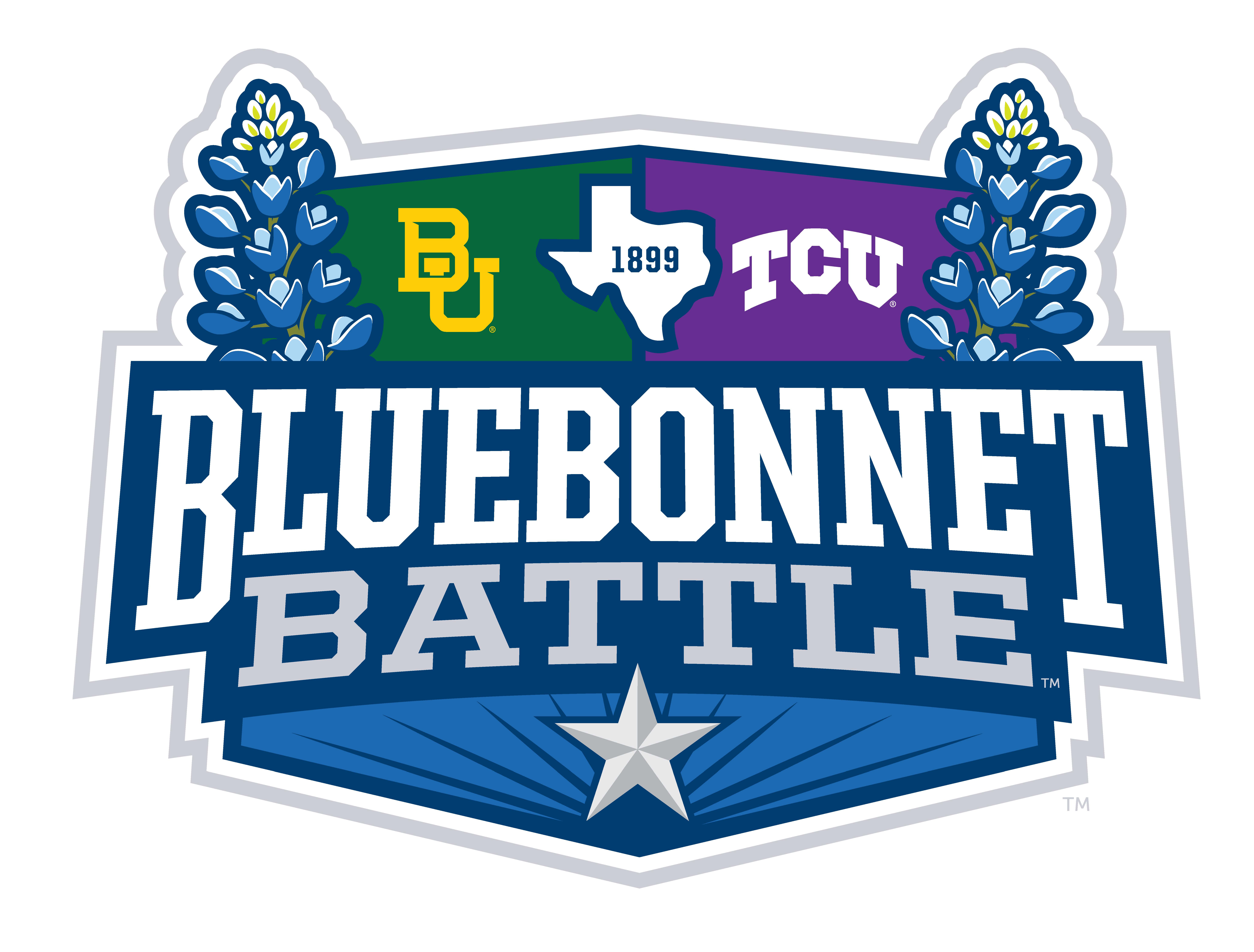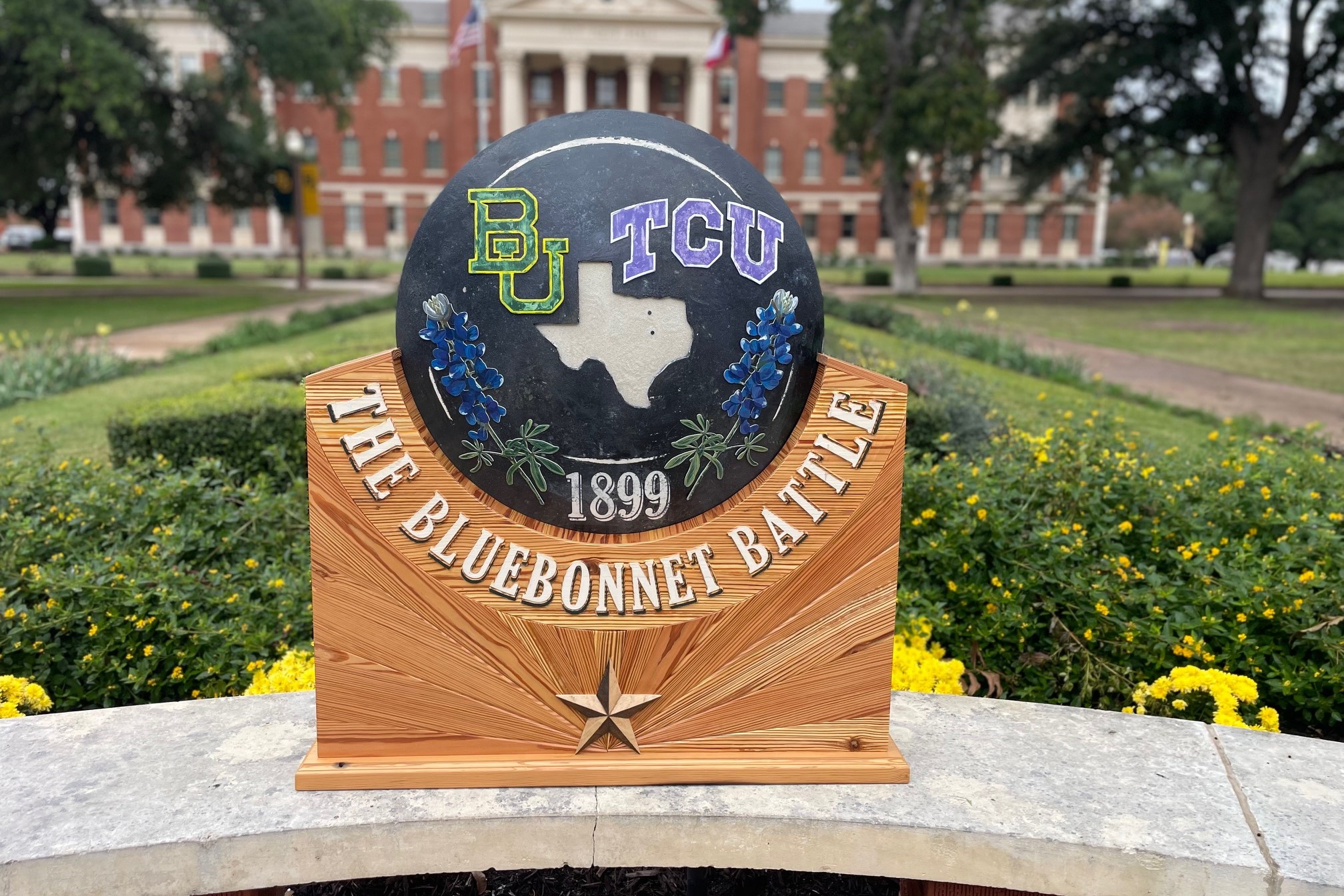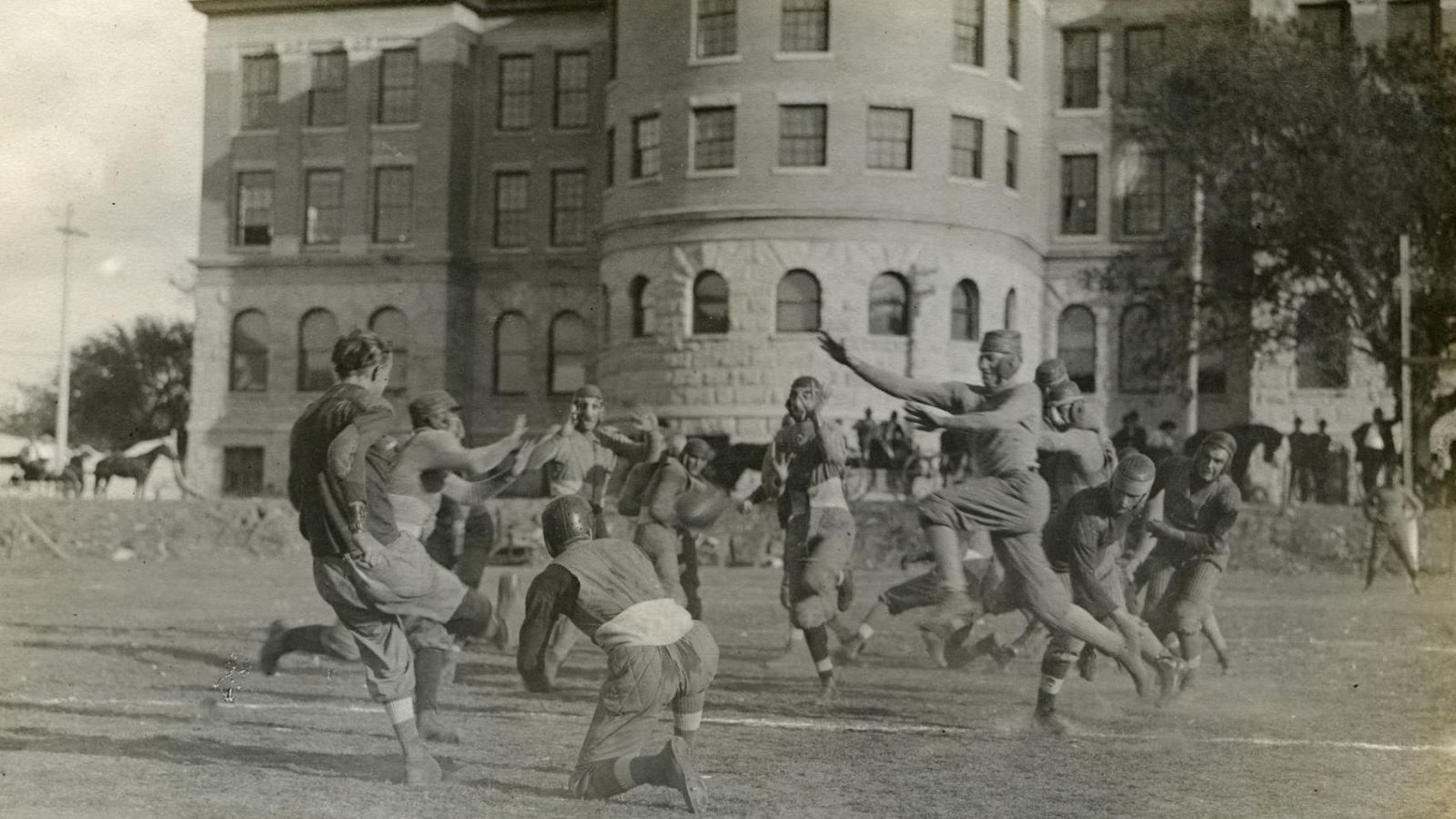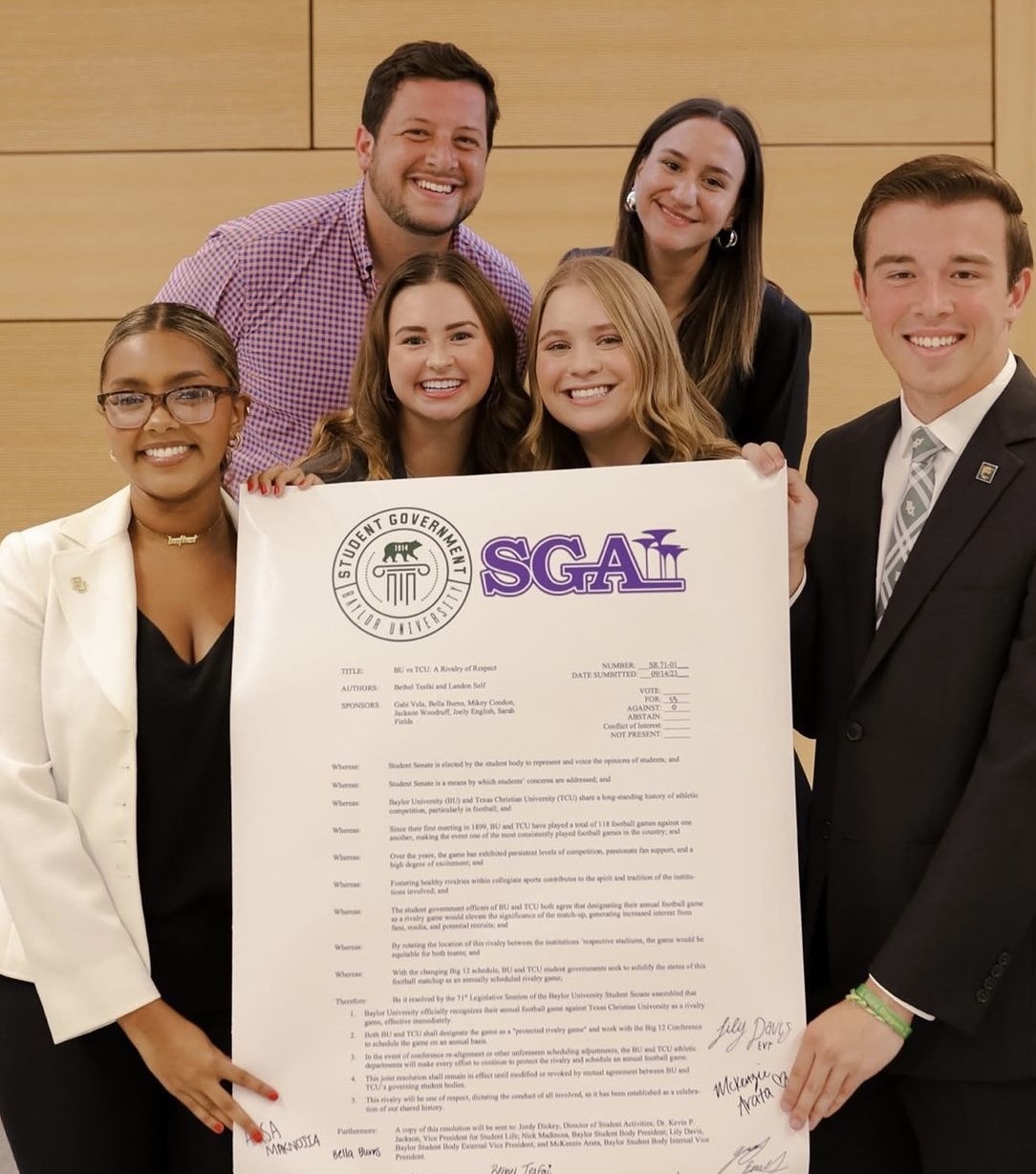Baylor and TCU Formalize Rivalry as The Bluebonnet Battle
Baylor-TCU set to overtake Texas-Texas A&M as the longest-standing college football rivalry in Texas with 119th meeting Nov. 18 in Fort Worth

Media Contacts:
Baylor University: Nick Madincea, Student Body President, 254-710-2368, Nick_Madincea1@baylor.edu; Lily Davis, Student Body External Vice President, 254-710-4703, Lily_davis3@baylor.edu
TCU: Joe Winick, Student Body President, 512-221-4254, joseph.winick@tcu.edu
WACO, Texas (Nov. 13, 2023) - Baylor University and TCU have formalized their century-long football rivalry through the commissioning of a trophy and officially naming the game after a months-long initiative led by the student governments of both universities. The Bluebonnet Battle will commemorate the 119th meeting of the football teams on Nov. 18 in Fort Worth, when Baylor-TCU overtakes Texas-Texas A&M to become the longest-standing college football rivalry in the state of Texas.
The name and trophy to be associated with the annual game was unveiled during a Zoom news conference on Nov. 13 with both teams’ head coaches, athletic directors, and student government leaders in attendance.
About the Bluebonnet Battle Name
The name “Bluebonnet Battle” was selected to pay homage to the State of Texas and the prairies in which both schools reside:
- More than the state flower of Texas, the Bluebonnet symbolizes bravery and sacrifice.
- Bluebonnets are well known for lining Interstate 35 that connects the two schools in Waco and Fort Worth.
- The Bluebonnet is a common thread in iconography found in Fort Worth, Waco, and Texas as a whole.
About the Trophy
The Bluebonnet Battle trophy is a circular battle shield, hand-forged in steel by Baylor alumnus Bryant Stanton of Stanton Studios in Waco, Texas. Additional facts:
The face of the shield features:
- The logos of both universities;
- An outline of the State of Texas adorned with Bluebonnets on either side and boldly displaying the rivalry’s official name; and
- The year 1899, when Baylor and TCU first met on the gridiron.
The trophy is two-and-a-half feet wide and rests in a mesquite wooden base, embellished with the lone star of Texas.
Formalizing the rivalry
According to Nick Madincea, Baylor’s Student Body President, the official rivalry will be transformative to the student experience at Baylor.
“TCU has been our informal rival for well over 100 years. Formalizing our rivalry through these efforts will only add to the game-day experience for members of the Baylor Family as well as TCU fans, in addition to becoming a hallmark of the vibrant athletic experience our students enjoy,” Madincea said. “There will be nothing like this in College Football.”
Baylor head football coach Dave Aranda emphasized the importance of the rivalry to both schools.
“We’re looking forward to continuing our long-standing rivalry with TCU as rivalries bring excitement, history and generations together throughout college football,” Aranda said. “We appreciate the Student Government Associations at both TCU and Baylor for their intentionality in bringing this rivalry together as the Bluebonnet Battle. We appreciate the conference in keeping this matchup with the new Big 12 schedule, as this annual tradition is incredibly important to both schools, and we are looking forward to celebrating the Bluebonnet Battle for many years to come.”
Baylor Vice President and Director of Athletics Mack Rhoades expressed his appreciation for the passion of the fans surrounding this game and to the student leaders for their efforts on this project.
"A priority for Baylor and TCU when we were talking through the future scheduling process for the Big 12 was to keep our game an annual matchup. This is the most-played game among Texas schools and it means so much to our fans, coaches and student-athletes. We appreciate the passion our fans have for this game and the thoughtfulness of both student governments in creating a moniker for this storied rivalry. We are looking forward to the trip to compete in Fort Worth this year and the many future matchups between our two great schools."
Joe Winick, TCU’s Student Body President, said the significance of this rivalry lies within the rich history of
the two institutions.
“This is a rivalry established by students, for students, and acts as a proud tradition that will be carried on by future generations of TCU Horned Frogs and Baylor Bears,” Winick said.
Winick also pointed out that the establishment of the Bluebonnet Battle coincides with TCU’s 150th anniversary.
“Our sesquicentennial year began with a National Championship appearance and ends with the Bluebonnet Battle,” he added.
TCU head football coach Sonny Dykes said about the rivalry, “Rivalries are what make college football special, and we are very proud to partner with Baylor on the Bluebonnet Battle. Thank you to the Student Government Associations at both TCU and Baylor for their initiative in coming together to create this trophy. It’s a great testament to how important our annual game is to both universities and especially the student bodies.”
TCU athletic director Jeremiah Donati praised the student-led effort noting, “I very much appreciate TCU Student Body President Joe Winick and Vice President Dominic Mendlik for their leadership in making the Bluebonnet Battle a reality. We are proud of our association with Baylor as not just members of the Big 12 Conference but also in sharing a rich football history together. With 118 all-time meetings, we have played Baylor more than any other opponent. It is a great and healthy rivalry as evidenced by being one of just four protected annual games in the new Big 12 scheduling matrix.”
The rivalry was formalized through the passage of a resolution by the student government legislatures of both universities and has a storied history that goes back over 100 years. In October 1899, when both campuses were located in Waco, Baylor and TCU met for the first time as cross-town rivals with the game resulting in a 0-0 tie. In 1910, TCU moved to its current home in Fort Worth and the rivalry continued.
In the years since, the rivalry has become storied with 36 shutouts and 44 games ending within 7 points. Recently, the game has had national implications: In 2014, a Baylor win eliminated TCU from the College Football Playoff conversation, and in 2022, a last-second field goal secured a TCU win, as the Horned Frogs continued their campaign to a College Football Playoff appearance.
Throughout the years, this rivalry game has marked the high and low points of each school’s season and has drawn the interest of alumni across the country, adding to the importance of winning the Bluebonnet Battle.
The Bluebonnet Battle trophy will be displayed at TCU’s Amon G. Carter Stadium on Nov. 18.
ABOUT BAYLOR UNIVERSITY
Baylor University is a private Christian University and a nationally ranked Research 1 institution. The University provides a vibrant campus community for more than 20,000 students by blending interdisciplinary research with an international reputation for educational excellence and a faculty commitment to teaching and scholarship. Chartered in 1845 by the Republic of Texas through the efforts of Baptist pioneers, Baylor is the oldest continually operating University in Texas. Located in Waco, Baylor welcomes students from all 50 states and more than 100 countries to study a broad range of degrees among its 12 nationally recognized academic divisions.


